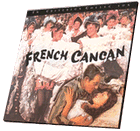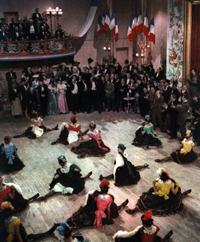

France drama
1955
color 105 min.
Director: Jean Renoir
CLV: $49.95 - available
1 disc, catalog # CC1306L

French Cancan,
produced at the Francoeur Studios in Saint-Maurice, had its Paris premiere in
May 1955, and was mostly successful as a fun musical with both the critics and
the public. In later decades, the critics around the world hailed the magnitude
of Jean Renoir's achievement in employing and exalting the cancan as a metaphor
for all artistic endeavors. Ultimately, French Cancan has turned out to
be the happiest and most exuberant ripple in Renoir's career as a river of
personal expression.In the Paris of the 1880s, the impresario Danglard (Jean
Gabin) decides to revive an old working-class dance which he christens "French
Cancan" to make it sound vaguely "foreign" and "naughty," and to entice British
and American tourists. He has troubles with his backers and their mistresses,
culminating in a catastrophic cat-fight between and Egyptian belly-dancer named
La Belle Abbesse (Maria Flix) and a poor working girl turned cancan star Nini
(Franoise Arnoul). Eventually, all the problems are solved, and French Cancan
is triumphantly launched at the newly unveiled Moulin Rouge.
Renoir wrote the
screenplay, based on an idea of André-Paul Antoine, and there is a pervasive
feeling of improvisation in most of the scenes. Renoir once remarked that he
had spoken the screenplay more than he had written it. The film is none of the
screen's most extraordinarily beautiful displays of late cinematic maturity.
Renoir's impressive personal testament on the collaborative arts is couched in
a way to reflect the softening contours of his sensuous world, and the result
is aesthetically parallel to such latter-day works as John Ford's The
Searchers and Luis Buuel's The Discreet Charm of the Bourgeoisie.
French Cancan is an artist's tribute to art, with Gabin's dedicated
impresario serving as an alter ego for Renoir. Against the pastel-colored
backgrounds of Auguste Renoir's Paris, all the caricatures in the movie attempt
to find some modus vivendi between art and life, but only the impresario
knows that ultimately his creation (the cancan and its dancers) will engulf the
audience, just as art engulfs life and then becomes part of living. Renoir
hurls his Cancan at the viewer, tempting us with the consuming
spectacle, which is not only a more stirring conception than John Huston's
art-gallery staging of the dance in Moulin Rouge, but one more
inherently kinetic and ineffably voluptuous.
Gabin the actor was a kind of
alter ego for Renoir as well. "I like French Cancan," Renoir wrote in
My Life and My Films, "because it gave me another chance to work with
Jean Gabin. It was a return to the past, to my companion in Les Bas
Fonds, La Grande Illusion, and La Bte Humaine, and I am
grateful to the cinema for having given me this comradeship. I love Gabin and
he loves me. But we do not know one another. He knows nothing of my private
life and I know nothing of his. Our relationship is entirely professional, but
I have a feeling that his tastes are pretty much the same as mine."
As
Franois Truffaut once note, Renoir repeatedly avoided the banality of a
romantic triangle by having three lovers competing for the hand of the beloved.
In French Cancan, Franoise Arnou's Nini is involved with Jean Danglard,
Gianni Esposito's Prince Alexandre, and Franco Pastorino's Paulo, the baker and
Nini's first love. The three suitors represent three perplexing choices.
Renoir's European sensibility does not allow him to indulge in John Huston's
puritanical pessimism in Moulin Rouge about artists and models facing
nothing but old age and death. Life and art are more complicated than that in
French Cancan. "Everyone has his reasons," complains Jean Renoir's
Octave in La Règle du Jeu, and everyone has his reasons in French
Cancan. Danglard lives from one show to the next, and from one woman to the
next. Nini finds that she cannot find fame and fidelity at the same time and in
the same place and in the same person. Yet though the show must go on, life
must go on, too, and the process of choice is not without pain and
cruelty.
Although Renoir was a man of the left for most of his adult life, he
never sacrificed ambiguity to ideology. He can caricature high society and the
aristocracy, but with remarkably little malice. By the same token, he does not
sentimentalize the poor. He remains a compassionate observer of the sheer
strangeness and variety of existence. It would be an oversimplification to
describe him as a humanist, and it would be a mistake to confuse his
pantheistic fatalism with aimlessness and artlessness. Only repeated viewings
of Renoir's films uncover the inexorable logic and lucidity of his style.
Still, of all his films, French Cancan is the one that bursts out again
and again with lyrical explosions of color, vitality, and sensuality. There is
unmistakably more to Renoir than meets the eye, but what an eye he has.
--
Andrew Sarris
CREDITS
Directed by: Jean Renoir
Written by: Jean
Renoir and André-Paul Antoine
Photographed by: Boris Lewin
Musical by:
Georges Van Paris




